search
1/5
THE KIMBOLTON CASTLE ARMCHAIRS
england , circa 1695 - 1705
SOLD
A highly important pair of William and Mary armchairs from the collections of the Dukes of Manchester, Kimbolton Castle.
Of ebonized beech with square upholstered seats and backs joined by curved, flared arms ending in spiral scrolls and set on pierced “corner horsebone,” or S-shaped, supports. The front legs also are cut through into three scrolls and are of similar, but inverted, form ending in large scroll feet. The front legs are joined by a pierced front stretcher formed by conjoined S- and C-scrolls. One front stretcher is impressed with an indistinct maker’s mark, possibly SC. The raked backs sharply overhang the back legs, which are effectively upright, although they do have triangular “heels” at the base. Square in section with turned details, the back legs are joined to the front legs by turned H-frame stretchers and to each other by a higher, turned, back stretcher. The18th century crimson velvet covers are trimmed with red fringe around the top and sides of the backs and with longer scalloped trim on the front and sides.
A highly important pair of William and Mary armchairs from the collections of the Dukes of Manchester, Kimbolton Castle.
Of ebonized beech with square upholstered seats and backs joined by curved, flared arms ending in spiral scrolls and set on pierced “corner horsebone,” or S-shaped, supports. The front legs also are cut through into three scrolls and are of similar, but inverted, form ending in large scroll feet. The front legs are joined by a pierced front stretcher formed by conjoined S- and C-scrolls. One front stretcher is impressed with an indistinct maker’s mark, possibly SC. The raked backs sharply overhang the back legs, which are effectively upright, although they do have triangular “heels” at the base. Square in section with turned details, the back legs are joined to the front legs by turned H-frame stretchers and to each other by a higher, turned, back stretcher. The18th century crimson velvet covers are trimmed with red fringe around the top and sides of the backs and with longer scalloped trim on the front and sides.
Provenance
Charles Montagu, 4th Earl and 1st Duke of Manchester (1662–1722), Kimbolton Castle, Huntingtonshire (now Cambridgeshire)
Sotheby’s, London, sold by the 11th Duke of Manchester O.B.E, 18 May 1973, lot 37
Spink & Son, Ltd., London (original label of 1973)
Sotheby’s, London, sold by the 11th Duke of Manchester O.B.E, 18 May 1973, lot 37
Spink & Son, Ltd., London (original label of 1973)
Stock number
R02.30
dimensions
More Details
Literature
Height: 49¹/₂ in (125.7 cm)
Width: 28¹/₄ in (71.7 cm)
Depth: 33¹/₈ in (84 cm)
Width: 28¹/₄ in (71.7 cm)
Depth: 33¹/₈ in (84 cm)
This pair of chairs comes from Kimbolton Castle, the estate of the Earls (later Dukes) of Manchester from 1650 to 1950. The dating of the chairs places them in the first decade of the Great Rebuilding of the castle undertaken by Charles Montagu, 4th Earl and 1st Duke of Manchester.
Spink & Son, London, purchased the two chairs in a 1973 Sotheby’s auction of property owned by the then-Duke of Manchester. A label identifies the chairs as “from a set of State furniture at Kimbolton Castle”. Two chairs from the Kimbolton suite appear in an illustration of The White Hall of the castle in a 1911 issue of Country Life . Although the arms of one chair in the photograph are blocked by a gateleg table, the same front legs, H-stretchers and back legs of both chairs and the arms of the one fully shown chair match those of the chairs here.
No chairs of this model appear in the catalogue of the auction of Kimbolton Castle property conducted by Knight, Frank & Rutley, 18–21 July 1949, suggesting that they were retained in the ducal family until the Sotheby’s sale of 1973.
The present chairs relate closely to an existing suite of chairs of the same period, now dispersed, from Rushbrooke Hall, Suffolk, seat of the Jermyn family that was later sold to the Rothschilds and demolished by fire in 1961. Eight of the Rushbrooke chairs were bequeathed in 1925 to the Lady Lever Art Gallery, Port Sunlight, near Liverpool, by the 1st Viscount Leverhulme and are now on loan to Hampton Court Palace. Two other chairs from the suite originally at Rushbrooke Hall are in the Treasurer’s House, York. A single Rushbrooke chair is in The Metropolitan Museum of Art, New York, a gift of Irwin Untermyer.
The Kimbolton chairs here have features similar enough to those from Rushbrooke Hall to surmise that they were produced in the same workshop. The Kimbolton and Rushbrooke chairs are of mortice and tenon construction throughout, with the central stretchers tenoned without pegs to the side stretchers. The side stretchers are tenoned and pegged to both the front and back legs, with all of the pegs exposed on the outer faces. On each chair, the front and back stretchers, the four seat rails and the bottom rails of the backs are tenoned but not pegged, unless there is a later pegged restoration. The Rushbrooke walnut armrests are pieced out to create the necessary width for the outward scroll of the arms and the peg traverses both sections; the Kimbolton armrests are made of one beech section and are not pegged to the front posts. The major difference between the Rushbrooke chairs and those offered here is the size of the scroll feet.
Yvonne Hackenbroch mentions that the Metropolitan chair, which, curiously, has a detachable cresting, is said to have come from Kimbolton Castle. Given the shape of the foot, however, it is more likely to have been part of the Rushbrooke suite.
The design of the present Kimbolton chairs points to a date around 1700. Reference to a “horsebone” chair first appears in 1686 invoices from Thomas Roberts (1685–1714), chairmaker to the royal household. “Horsebone” is the expression Roberts used to describe a broken scroll-formed leg. The variant “corner horsebone” design that the present chairs display is first listed in invoices from Roberts of the early 1690s. Adam Bowett cites “2 Elbow Chaires of Wallnuttree Carved horsebone on the corners” that appear in a bill Roberts submitted in 1693.[vi] Thereafter, “corner horsebone feet” and elbows are regularly recorded. “To turn on the corner” is another phrase found in 1696 invoices that apparently describes other “Elbow Chaires” with “corner horsebone feet.” Flared feet and bold, scrolling arm terminals make their appearance at the same time.
Another example of “corner horsebone” chairs is the famous 1701 set of armchairs in beechwood, six of which survive along with a settee of slightly different design and a state bed at Drayton House, Northamptonshire.[vii]
Adam Bowett also remarks that the term “horsebone” disappears entirely from Thomas Roberts’s invoices after 1704, implying that the taste for this form had changed by the accession of Queen Anne in 1702.
Spink & Son, London, purchased the two chairs in a 1973 Sotheby’s auction of property owned by the then-Duke of Manchester. A label identifies the chairs as “from a set of State furniture at Kimbolton Castle”. Two chairs from the Kimbolton suite appear in an illustration of The White Hall of the castle in a 1911 issue of Country Life . Although the arms of one chair in the photograph are blocked by a gateleg table, the same front legs, H-stretchers and back legs of both chairs and the arms of the one fully shown chair match those of the chairs here.
No chairs of this model appear in the catalogue of the auction of Kimbolton Castle property conducted by Knight, Frank & Rutley, 18–21 July 1949, suggesting that they were retained in the ducal family until the Sotheby’s sale of 1973.
The present chairs relate closely to an existing suite of chairs of the same period, now dispersed, from Rushbrooke Hall, Suffolk, seat of the Jermyn family that was later sold to the Rothschilds and demolished by fire in 1961. Eight of the Rushbrooke chairs were bequeathed in 1925 to the Lady Lever Art Gallery, Port Sunlight, near Liverpool, by the 1st Viscount Leverhulme and are now on loan to Hampton Court Palace. Two other chairs from the suite originally at Rushbrooke Hall are in the Treasurer’s House, York. A single Rushbrooke chair is in The Metropolitan Museum of Art, New York, a gift of Irwin Untermyer.
The Kimbolton chairs here have features similar enough to those from Rushbrooke Hall to surmise that they were produced in the same workshop. The Kimbolton and Rushbrooke chairs are of mortice and tenon construction throughout, with the central stretchers tenoned without pegs to the side stretchers. The side stretchers are tenoned and pegged to both the front and back legs, with all of the pegs exposed on the outer faces. On each chair, the front and back stretchers, the four seat rails and the bottom rails of the backs are tenoned but not pegged, unless there is a later pegged restoration. The Rushbrooke walnut armrests are pieced out to create the necessary width for the outward scroll of the arms and the peg traverses both sections; the Kimbolton armrests are made of one beech section and are not pegged to the front posts. The major difference between the Rushbrooke chairs and those offered here is the size of the scroll feet.
Yvonne Hackenbroch mentions that the Metropolitan chair, which, curiously, has a detachable cresting, is said to have come from Kimbolton Castle. Given the shape of the foot, however, it is more likely to have been part of the Rushbrooke suite.
The design of the present Kimbolton chairs points to a date around 1700. Reference to a “horsebone” chair first appears in 1686 invoices from Thomas Roberts (1685–1714), chairmaker to the royal household. “Horsebone” is the expression Roberts used to describe a broken scroll-formed leg. The variant “corner horsebone” design that the present chairs display is first listed in invoices from Roberts of the early 1690s. Adam Bowett cites “2 Elbow Chaires of Wallnuttree Carved horsebone on the corners” that appear in a bill Roberts submitted in 1693.[vi] Thereafter, “corner horsebone feet” and elbows are regularly recorded. “To turn on the corner” is another phrase found in 1696 invoices that apparently describes other “Elbow Chaires” with “corner horsebone feet.” Flared feet and bold, scrolling arm terminals make their appearance at the same time.
Another example of “corner horsebone” chairs is the famous 1701 set of armchairs in beechwood, six of which survive along with a settee of slightly different design and a state bed at Drayton House, Northamptonshire.[vii]
Adam Bowett also remarks that the term “horsebone” disappears entirely from Thomas Roberts’s invoices after 1704, implying that the taste for this form had changed by the accession of Queen Anne in 1702.
Country Homes–Gardens Old & New: Kimbolton Castle.–I. Huntingtonshire, A Seat of the Duke of Manchester,” Country Life, Vol. XXX, No. 768 (23 September 1911): color plate page 449 and figure illustration of The White Hall page 444.
“Country Homes–Gardens Old & New: Kimbolton Castle.–II. Huntingtonshire, A Seat of the Duke of Manchester,” Country Life, Vol. XXX, No. 769 (30 September 1911): 479.
For a detailed discussion of the Rushbrooke chairs, see Lucy Wood, The Upholstered Furniture in the Lady Lever Art Gallery (Yale University Press, 2009), vol. 1, no. 5.
Adam Bowett, English Furniture 1660–1714 from Charles II to Queen Anne (Antique Collectors’ Club, 2002), plate 8:20, page 240.
Lucy Wood, The Upholstered Furniture in the Lady Lever Art Gallery, fig. 120; and Yvonne Hackenbroch, English Furniture with Some Furniture of Other Countries in the Irwin Untermyer Collection (Thames & Hudson, 1958), 18 and plate 45.
Adam Bowett, “The English ‘horsebone’ chair, 1685–1710,” Burlington Magazine CXLI (May 1999): 263–70.
Geoffrey Beard in Upholsterers and Interior Furnishing in England 1530–1840 (Yale University Press, 1997) posits a date of 1685.
R. Edwards, The Dictionary of English Furniture, vol. I, colour plate IX, (year 2000 reprint)
“Country Homes–Gardens Old & New: Kimbolton Castle.–II. Huntingtonshire, A Seat of the Duke of Manchester,” Country Life, Vol. XXX, No. 769 (30 September 1911): 479.
For a detailed discussion of the Rushbrooke chairs, see Lucy Wood, The Upholstered Furniture in the Lady Lever Art Gallery (Yale University Press, 2009), vol. 1, no. 5.
Adam Bowett, English Furniture 1660–1714 from Charles II to Queen Anne (Antique Collectors’ Club, 2002), plate 8:20, page 240.
Lucy Wood, The Upholstered Furniture in the Lady Lever Art Gallery, fig. 120; and Yvonne Hackenbroch, English Furniture with Some Furniture of Other Countries in the Irwin Untermyer Collection (Thames & Hudson, 1958), 18 and plate 45.
Adam Bowett, “The English ‘horsebone’ chair, 1685–1710,” Burlington Magazine CXLI (May 1999): 263–70.
Geoffrey Beard in Upholsterers and Interior Furnishing in England 1530–1840 (Yale University Press, 1997) posits a date of 1685.
R. Edwards, The Dictionary of English Furniture, vol. I, colour plate IX, (year 2000 reprint)

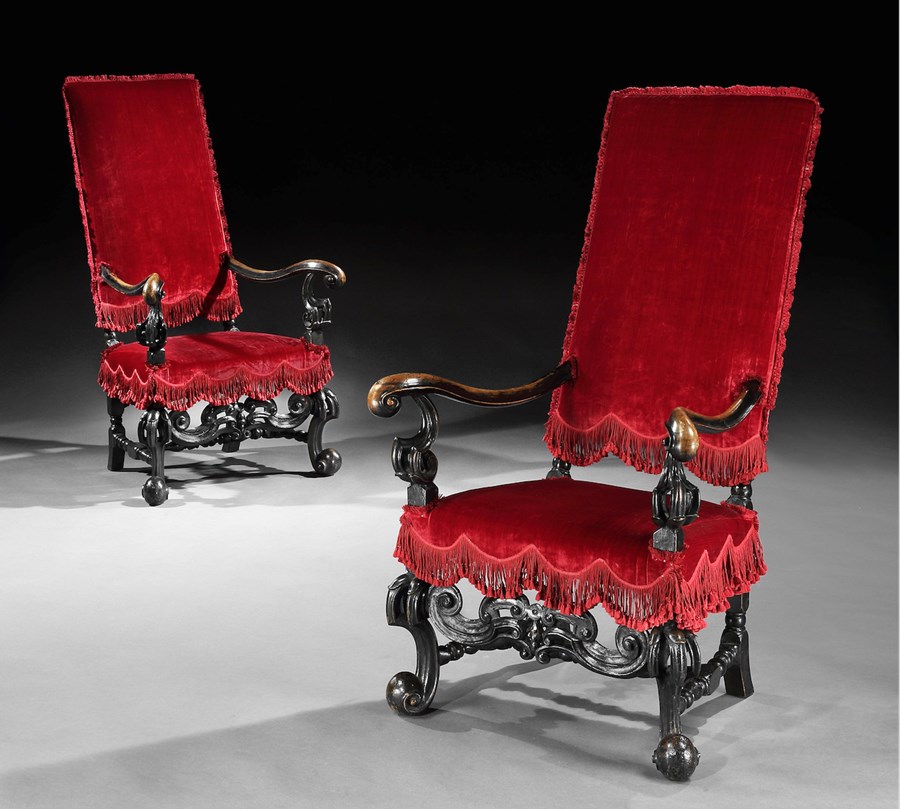
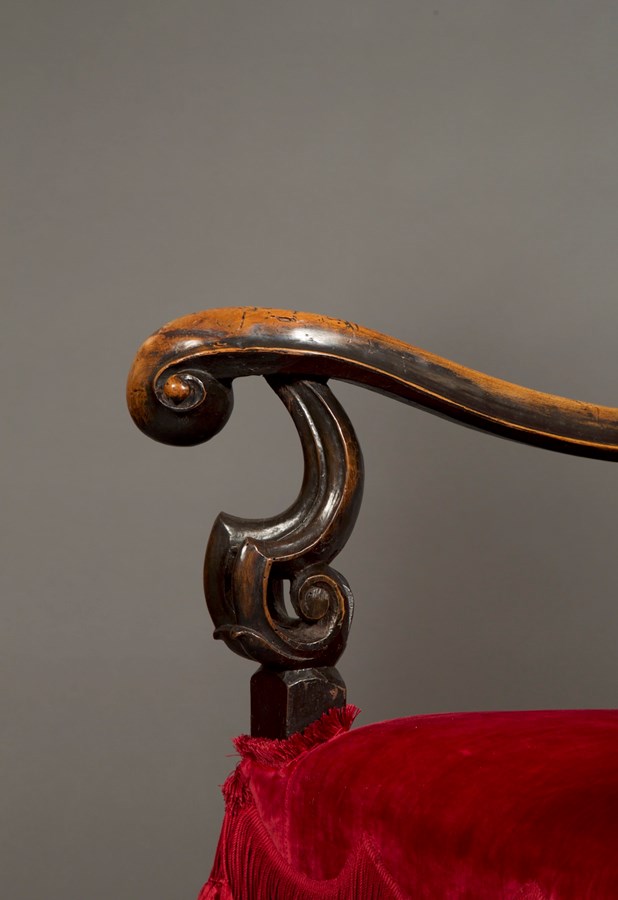
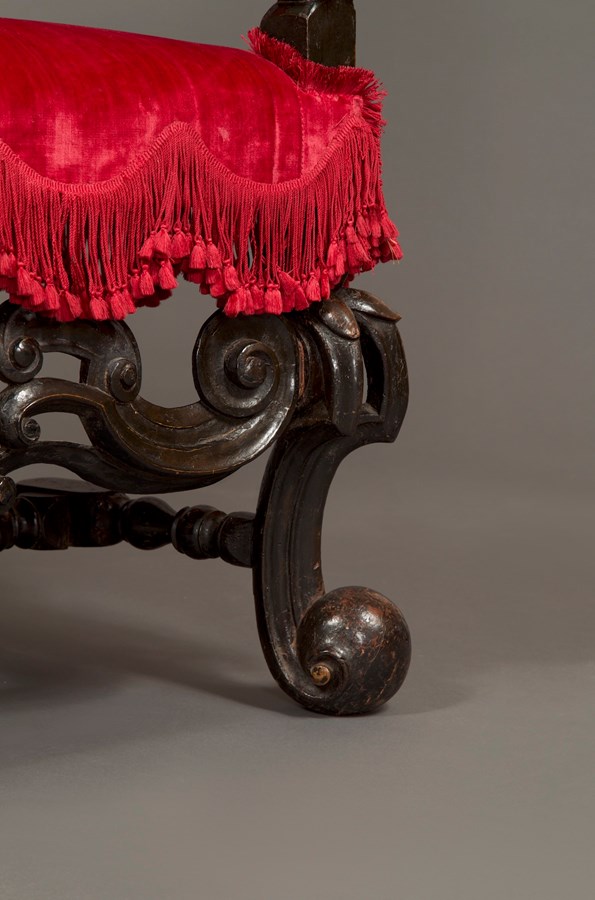
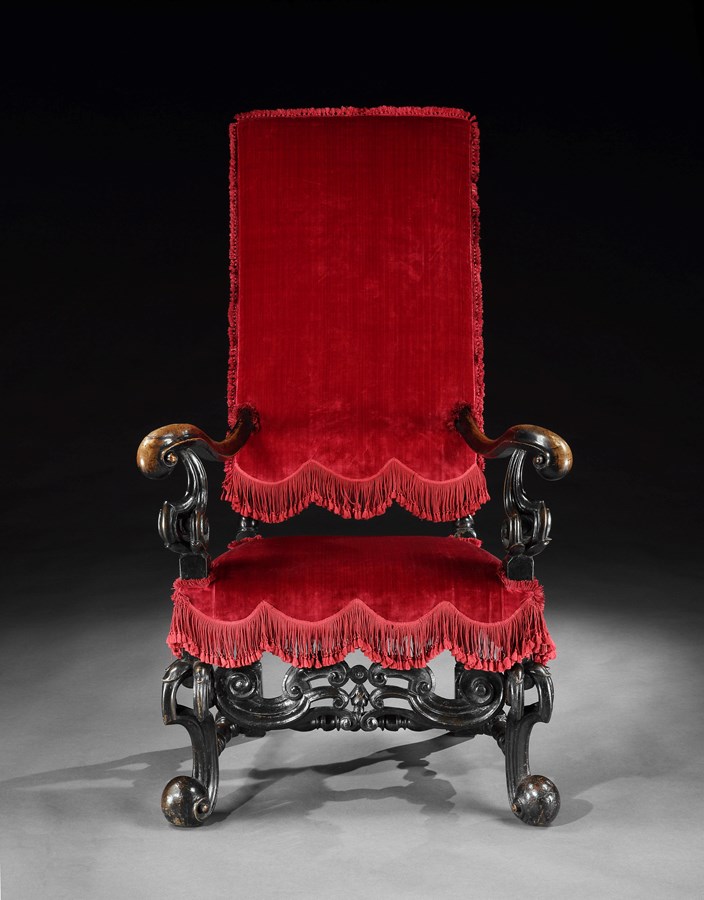
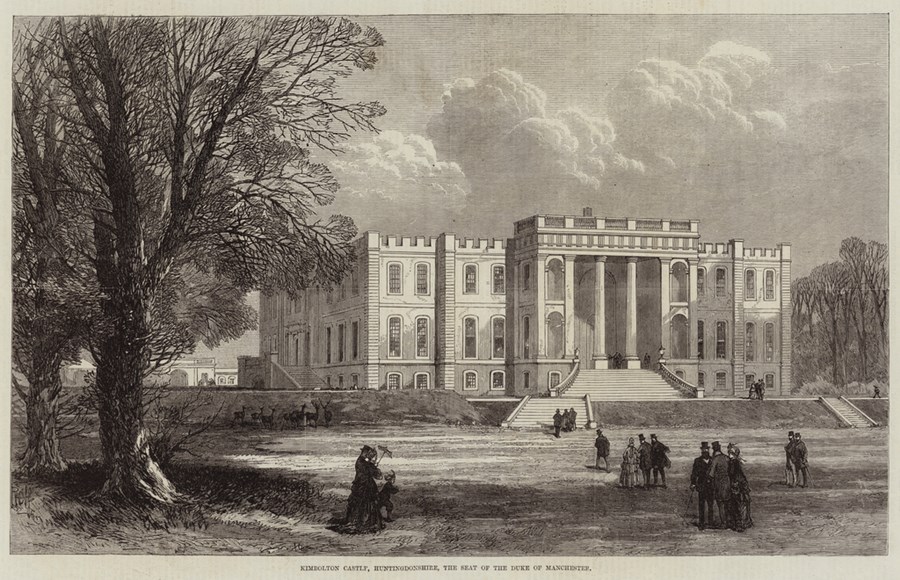


 enquire
enquire
 +44 (0)20 7839 5671
+44 (0)20 7839 5671
 +44 (0)7725 332 665
+44 (0)7725 332 665